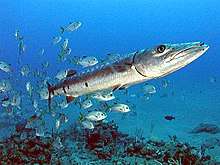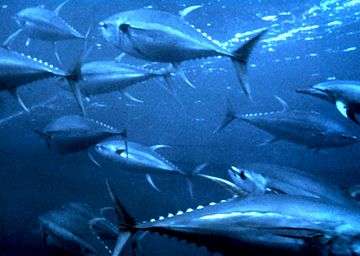Ecopath
Ecopath with Ecosim (EwE) is a free and open source ecosystem modelling software suite, initially started at NOAA by Jeffrey Polovina, but has since primarily been developed at the formerly UBC Fisheries Centre of the University of British Columbia. In 2007, it was named as one of the ten biggest scientific breakthroughs in NOAA's 200-year history. The NOAA citation states that Ecopath "revolutionized scientists' ability worldwide to understand complex marine ecosystems".[1] Behind this lie more than two decades of development work in association with Villy Christensen, Carl Walters, Daniel Pauly, and other fisheries scientists,[2] followed with the provision of user support, training and co-development collaborations. Per January 2019 there are an estimated 8000+ users across academia, non-government organizations, industry and governments in 150+ countries.
 | |
| Developer(s) | Ecopath Research and Development Consortium |
|---|---|
| Initial release | 1992 |
| Stable release | 6.6.1
/ 8 May 2020 |
| Preview release | 6.6 Beta 5
/ 21 September 2019 |
| Repository | http://sources.ecopath.org/trac/Ecopath |
| Written in | Visual Basic.NET, C# |
| Operating system | Windows Vista (non-supported), 7, 8*, 10 (EwE desktop version), Unix and Linux (EwE core via Mono) |
| Platform | .NET Framework 4.5 |
| Available in | English |
| Type | Ecosystem modeling |
| License | GPL v2 |
| Website | http://www.ecopath.org |
Components
EwE has three main components:
- Ecopath – a static, mass-balanced snapshot of the system[3]
- Ecosim – a time dynamic simulation module for policy exploration[4]
- Ecospace – a spatial and temporal dynamic module designed for exploring the combined impacts of fishing, the placement of protected areas[5], and changing environmental conditions.
Capabilities
The Ecopath software package can be used to:
- address ecological questions[6]
- evaluate ecosystem effects of fishing[7]
- explore management policy options[8]
- analyze impact and placement of marine protected areas[9]
- predict movement and accumulation of contaminants and tracers (Ecotracer)[10][11]
- model effect of environmental changes,[12][13]
- facilitate end-to-end ecosystem model construction[14]
Development Ecopath version 6.0[15] received support from the Lenfest Ocean Program and the Pew Charitable trusts. In 2011 the Ecopath Research and Development Consortium was founded to share the responsibility of maintaining and further developing the approach with institutions around the world. EwE exclusively relyies on user involvement for continued software development and releases of new versions.
The desktop version of Ecopath with Ecosim runs only on Windows and requires Microsoft Access database drivers version 2007 or newer. The computational core of Ecopath with Ecosim can be executed on other operating systems such as Unix or Linux using the Mono common language runtime.[16] Spin-off versions in R, Matlab and Fortran are developed independently of the main desktop version of EwE, and are not supported by the Ecopath Research and Development Consortium.
Funding
In 2013, development efforts were centralized under Ecopath International Initiative, Spain, which coincided with a switch to a community-driven development model. As the approach does not receive any core funding, the Ecopath with Ecosim approach now relies entirely on user-contributed project funding for continued development and releases.
References
- NOAA, 2007. ECOPATH Modeling: Precursor to an Ecosystem Approach to Fisheries Management [WWW Document]. URL http://celebrating200years.noaa.gov/breakthroughs/ecopath/welcome.html (accessed 8.26.12).
- Smikle, S.G., V. Christensen and K.A. Aiken (2010). "A review of caribbean ecosystems and fishery resources using ECOPATH models". Revue Etudes Caribéennes, n°15, https://etudescaribeennes.revues.org/4529
- Christensen, V. and Pauly, D., 1992. Ecopath II - a software for balancing steady-state ecosystem models and calculating network characteristics. Ecological Modelling, 61:169-185.
- Walters, C., Christensen, V. and Pauly, D., 1997. Structuring dynamic models of exploited ecosystems from trophic mass-balance assessments. Rev Fish Biol Fish, 7:139-172
- Walters, C., Pauly, D. and Christensen, V., 1999. Ecospace: Prediction of mesoscale spatial patterns in trophic relationships of exploited ecosystems, with emphasis on the impacts of marine protected areas. Ecosystems, 2:539-554.
- Christensen, V. and Pauly, D. (Editors), 1993. Trophic Models of Aquatic Ecosystems. ICLARM Conference Proceedings 26, Manila, 390 p.
- Walters, C.J., Christensen, V., Martell, S.J. and Kitchell, J.F., 2005. Possible ecosystem impacts of applying MSY policies from single-species assessment. ICES J Mar Sci, 62:558-568.
- Christensen, V. and Walters, C.J., 2004. Trade-offs in ecosystem-scale optimization of fisheries management policies. Bull Mar Sci, 74:549-562
- Walters, C.J. and Martell, S.J.D., 2004. Fisheries Ecology and Management. Princeton University Press, Princeton, 399 p.
- Christensen, V. and Booth, S., 2006. Ecosystem modeling of dioxin distribution patterns in the marine environment. Chapter 6. In: J. Alder and D. Pauly (Editor), On the multiple uses of small pelagic fishes: from ecosystems to markets. UBC Fisheries Centre Research Reports 14(3). Fisheries Centre, University of British Columbia [ISSN 1198-6727], Vancouver
- Walters, William J.; Christensen, Villy (2018). "Ecotracer: analyzing concentration of contaminants and radioisotopes in an aquatic spatial-dynamic food web model". Journal of Environmental Radioactivity. 181: 118–127. doi:10.1016/j.jenvrad.2017.11.008. ISSN 0265-931X. PMID 29145014.
- Guénette, Sylvie; Heymans, Sheila JJ; Christensen, Villy; Trites, Andrew W (2006). "Ecosystem models show combined effects of fishing, predation, competition, and ocean productivity on Steller sea lions (Eumetopias jubatus) in Alaska". Canadian Journal of Fisheries and Aquatic Sciences. 63 (11): 2495–2517. doi:10.1139/f06-136. ISSN 0706-652X.
- Christensen, Villy; Coll, Marta; Steenbeek, Jeroen; Buszowski, Joe; Chagaris, Dave; Walters, Carl J. (2014). "Representing Variable Habitat Quality in a Spatial Food Web Model". Ecosystems. 17 (8): 1397–1412. doi:10.1007/s10021-014-9803-3. ISSN 1432-9840.
- Steenbeek, Jeroen; Coll, Marta; Gurney, Leigh; Mélin, Frédéric; Hoepffner, Nicolas; Buszowski, Joe; Christensen, Villy (2013). "Bridging the gap between ecosystem modeling tools and geographic information systems: Driving a food web model with external spatial–temporal data". Ecological Modelling. 263: 139–151. doi:10.1016/j.ecolmodel.2013.04.027. ISSN 0304-3800.
- Christensen, V. and Lai, S., 2007. Ecopath with Ecosim 6: the sequel. The Sea Around Us Project Newsletter, 43:1-4 (September–October).
- Steenbeek, Jeroen; Buszowski, Joe; Christensen, Villy; Akoglu, Ekin; Aydin, Kerim; Ellis, Nick; Felinto, Dalai; Guitton, Jerome; Lucey, Sean; Kearney, Kelly; Mackinson, Steven; Pan, Mike; Platts, Mark; Walters, Carl (January 2016). "Ecopath with Ecosim as a model-building toolbox: Source code capabilities, extensions, and variations". Ecological Modelling. 319: 178–189. doi:10.1016/j.ecolmodel.2015.06.031.

